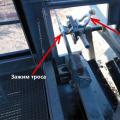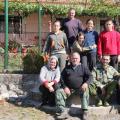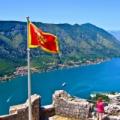Map of Latvia. Map of Latvia in Russian Latvia show on the map
Map of Latvia from satellite. Explore the satellite map of Latvia online in real time. A detailed map of Latvia was created based on high-resolution satellite images. As close as possible, the satellite map of Latvia allows you to study in detail the streets, individual houses and attractions of Latvia. The map of Latvia from a satellite can easily be switched to regular map mode (diagram).
Latvia– one of the Baltic states, which is located in northeastern Europe. The shores of Latvia are washed by the Baltic Sea. The capital of the country is the city of Riga. Despite the fact that the official language is Latvian, most residents understand and speak Russian well.
Most of the attractions are concentrated in Riga, the cultural center of the country. This city is rightfully considered one of the most beautiful in Europe. This is an ancient city with a huge number of attractions. With its monuments and architecture, Riga has rightfully earned a place on the UNESCO World Heritage List.
Latvia is a fairly popular country in terms of tourism. In the summer, many tourists come to the Baltic Sea coast for an excellent seaside holiday. Jurmala is considered the most prestigious summer resort. In addition to ordinary residents of Latvia, film and pop stars vacation in Jurmala. This city is also famous for the annual New Wave competition.
The Republic of Latvia or Latvia is a Northern European state located on the shores of the Baltic Sea. The capital of the state is the city of Riga. From 1944 until 1991, the country was part of the former Soviet Union.
Map of Latvia in Russian.
In the east, Latvia borders with Russia, in the south there are borders with Belarus and Lithuania, in the north with Estonia. The total length of the land borders is 1,862 kilometers. The west of the country is washed by the waters of the Gulf of Riga and the Baltic Sea for 500 kilometers. The state borders Sweden by sea. The total area of the country is 64.5 thousand square kilometers. 2 million 217 thousand people live in Latvia. Almost half of the country's territory (about 44%) is occupied by forests. There are more than 3 thousand lakes and 12 thousand rivers in Latvia. Daugava (Western Dvina) is the largest river. In the north of the country there is the Kurzeme Peninsula with Cape Kolkasrags. Mount Gaizinkalns is the highest point, its height is 311 meters.

Detailed map of Latvia with cities.
Latvia is a parliamentary republic. This is a unitary state with 110 territories and 9 large cities with republican status. Latvia is a member of the European Union and NATO. Since 2004, it has become a member of the Schengen Agreement.

Road map of Latvia.
Latvia – state in Northern Europe, washed by the waters of the Baltic Sea in the west. On a detailed map of Latvia you can find the country's border with four countries: Estonia in the north, Russia in the east, Belarus in the southeast and Lithuania in the south.
Latvia is a major financial and logistics center, as well as an exporter of wood, petroleum products and medicines.
Latvia on the world map: geography, nature and climate

On the world map, Latvia is located in Northern Europe, in the Baltic states, and is washed by the Baltic Sea from the west and the Gulf of Riga from the north-west. The territory of Latvia stretches from north to south for 250 km, and from west to east – 450 km. The total length of the borders is 1382 km.
Minerals
Latvia does not have significant mineral reserves, however, the country has deposits of gravel, clay, peat, gypsum, limestone, oil and iron ores.
Relief
Most of Latvia’s topography is represented by slightly hilly plains 100–200 m high, which are the western edge of the East European Plain:
- in the west and north-west of the country, along the coast of the Baltic Sea, there is the Primorskaya Lowland;
- in the southern part of Latvia there are the Zemgale lowland, Augšzeme and South Kurzeme uplands;
- the eastern part of the country is occupied by the East Latvian lowland, Latgale Aluksna and uplands;
- in the north of Latvia there is the North Latvian Lowland;
- on the map of Latvia in Russian in the central part of the country you can find the Vidzeme Upland, the Riga Plain and the Central Latvian Lowland.
The highest point in Latvia is Mount Gaizinkalns (312 meters), which belongs to the Vidzeme Upland.
Hydrography
More than 700 rivers flow through the territory of Latvia, the longest of them is the Daugava - its length within the country is 357 km (total length - 1020 km). Other large rivers are the Gauja, Lielupe, and Venta. All rivers belong to the Baltic Sea basin and usually have a mixed supply - snow, rain and underground. Rivers freeze in November–December and open in March–April.
There are about 3,000 lakes in Latvia, occupying 1.5% of the country's territory. Most of the lakes are of glacial origin, and the largest of them is Lake Lubans with an area of 81 km 2. Wetlands account for about 10% of Latvia's area, most of which are located in the east of the country.
Flora and fauna
The most common soils in Latvia are sod-podzolic, sod-carbonate, gley and peat-bog soils.
Forests occupy 40% of the country's area, coniferous forests (pine, spruce) account for 2/3, and deciduous forests (birch, aspen, alder) account for 1/3 of all forests.
The fauna of Latvia is represented by 63 species of mammals, 300 species of birds, 29 species of fish, 20 species of reptiles and amphibians, 17,500 species of invertebrates. The most frequently encountered animals are roe deer, deer, wild boar, hares, and wolves. Rare representatives of the fauna can be found here: black stork, raccoon dog and corncrake. In the Baltic Sea and inland waters of the country there are pike, pike-perch, trout, catfish, perch, syrty, roach, salmon and other fish.
Latvia has 4 national parks, 5 nature reserves and many nature reserves. The largest environmental protection zone is the Gauja National Park, located in the central part of the country and known primarily for its sandy cliffs along the river of the same name. There are also historical attractions here - Turaida and Lielstraup castles, built in the 13th century.
Climate
The climate of Latvia is temperate maritime and temperate continental, significantly softened by the proximity of the Baltic Sea and moistened by the influence of Atlantic winds - the average annual air humidity is 81%. Winter in the country is mild and snowy, the average temperature in January is from -1 to -5 °C. Summer is cool and humid, the average temperature in July is from +16 to +18 °C. The average annual air temperature is +6 °C, and the average annual precipitation is from 600 to 700 mm. The country experiences predominantly cloudy and cloudy weather - there are only 30 - 40 sunny days a year.
Map of Latvia with cities. Administrative division of the country

The territory of Latvia consists of 110 regions and 9 republican cities:
- Rigi,
- Daugavpils,
- Liepaja,
- Jelgava,
- Jurmala,
- Ventspils,
- Rezekne,
- Valmiera,
- Jekabpils.
Largest cities in Latvia
- Riga- the capital and largest city not only of Latvia, but also of the Baltic states, an important economic and cultural center of the country. The city is located on both banks of the Daugava River and the coast of the Gulf of Riga. The population of Riga has been steadily declining since the collapse of the Soviet Union and today stands at 638 thousand people, of which the most numerous are Latvians (46%) and Russians (38%).
- Daugavpils- the second largest and most populous city (86 thousand people) in Latvia, located on both banks of the river of the same name, 30 km from the border with Belarus and Lithuania. Metalworking, chemical and food industries, and more recently electronics, are developed in Daugavpils. The main attraction of the city is the Daugavpils Fortress, built in the 19th century. On a map of Latvia with cities in Russian, Daugavpils can be found in the south of the country.
- Liepaja is a city in southwestern Latvia and an important port on the Baltic Sea coast. 70 thousand people live in Liepaja. Cargo and passenger transportation, construction, metallurgy, light and food industries are the most important sectors of the city's economy.
The Baltic country in North-Eastern Europe is washed by the waters of the Baltic Sea and the Gulf of Riga, and borders on land with, and. In a state with an area of 64.5 thousand square meters. km there are 2.4 million citizens. The capital is the city of Riga. The Riga seaside is famous for its sandy beaches surrounded by pine forests, clean lakes and fresh air.
The territory of Latvia is flat, only in the east and west there are small hills, the most significant of which are the Vidzeme Upland, which reaches 312 m above sea level. There are 2,585 rivers and 2,288 lakes in small Latvia.
The climate is transitional - from maritime to continental, moderated by the Baltic Sea. Winds from the Atlantic bring precipitation, so the sky over the country is almost always overcast, and there are only 30–40 sunny days a year. It rains least in May. The average summer temperature does not exceed +20 °C; heat around +30 °C is considered abnormal in Latvia. Winters are mild, usually January temperatures do not reach −10 °C.
Once upon a time, the lands of modern Latvia were covered with forests; in places where trees were cut down, meadows were formed, suitable for grazing livestock. Only 1% of the land is natural fields. 10% of the territories are wetlands, mainly in the east of the country and in coastal areas. Over time, many swamps turned into lakes or dried out and became fertile soils.
The fauna differs little from that of northern Europe; 62 species of mammals are found here, some of which wander into the country, for example, the spotted seal. In Latvia there are about three hundred species of birds, including rare ones, 29 species of fish, and more than 17 thousand species of invertebrates.
 The best cable cars in Russia Cable car
The best cable cars in Russia Cable car Size and ethnic composition of the population of Montenegro
Size and ethnic composition of the population of Montenegro Dispelling the myths shown by the Russian media
Dispelling the myths shown by the Russian media